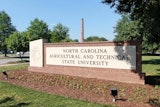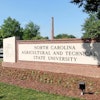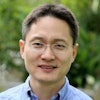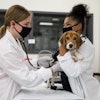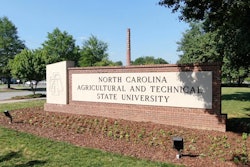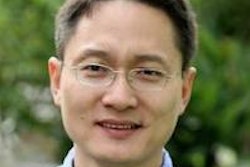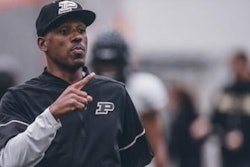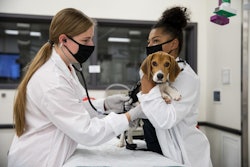For kids with an interest in science, technology, engineering and mathematics (STEM), museums can provide valuable learning experiences and significant opportunities that create pipelines to higher education.
In early June, 100 high school students in New York City presented their original research to fellow teen scientists, mentors, friends and family at the American Museum of Natural History (AMNH). It was the culmination of a year of work.
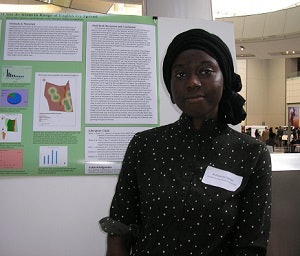 A student presenting research at AMNH.
A student presenting research at AMNH.While the AMNH is a vast, internationally known institution, its programs can be replicated in whole or in part in museums, colleges, laboratories and hospitals around the country, providing pipelines for students with interest in STEM fields. It participates in national conversations around STEM and belongs to the Association of Science and Technology Centers.
This year marked the 5th Annual Student Research Colloquium of the NYC Science Research Mentoring Consortium. The students who presented spent the year from summer 2017 to spring 2018 working on projects that are part of AMNH’s Science Research Mentoring Program (SRMP) and BridgeUp: STEM or one of SRMP’s 21 partner institutions. Projects ranged from better understanding the behavioral patterns of urban wildlife to exploring the cosmos.
Dr. Preeti Gupta, AMNH director of Youth Learning and Research, strategizes how to create equitable learning environments for New York City youth where they can engage in content learning that is innovative, rigorous and relevant. There are short, immersive programs as well as long-term projects.
Middle school kids are exposed to things typically not available in school that could get them excited about science. Each summer, there are one-week institutes that serve hundreds of students.
“They will be able to engage with museum content in a way where they’ll be able to understand science research, connect with scientists at the museum, understand the processes of scientific investigation and have several opportunities to consider STEM careers as part of their trajectory,” says Gupta.
Then, there are more in-depth programs for students who already have significant interest, such as the Lang Science Program, which admits 20 sixth-graders every year. Those students remain with the program until they graduate from high school. Over the course of seven years, they experience content-rich programming in biology and physical sciences, design their own research projects, learn about AMNH exhibits and receive college and career preparation. The retention rate is 85 percent.
“A lot of the publication work I’ve led has been about pushing our knowledge about how we work with youth in out-of-school-time learning in terms of identity development and STEM career exposure. We do not just look at their grades, but also look at the way people play roles in their identity development, which then connects to their persistence with college,” says Gupta, who oversees SRMP and Lang and works on long-term strategies and best practices.
Gupta says when these students get to college, they outperform their peers in the gatekeeper STEM classes. They also feel confident reaching out to professors and asking for research jobs, which is typically a daunting prospect.
 Dr. Preeti Gupta
Dr. Preeti Gupta“Not only are they approaching, which is the first step, they are eloquent in how they present themselves,” says Gupta.
AMNH also has BridgeUp: STEM, a suite of programs going into its fifth year focusing on computer science that offers tuition-free coding courses for high school girls, a post-baccalaureate fellowship for women and an annual hackathon for professional developers addressing computational challenges in a given scientific discipline. The program’s director, Dr. Yvonne De La Peña, says girls develop confidence and a desire to go into the technological workforce.
“In the tech industry and in STEM, we’re still facing a lot of challenges as women,” says De La Peña. “We not only want them to develop their skills as coders, programmers and doing computation science, we also want them to develop their identity as someone who’s capable of coding and presenting their work with confidence.”
Mentorship
“We are looking for mentors who are doing innovative work and within that innovative work can describe a piece of that work they think students can do with them,” says Gupta. “We work with the scientists so they can craft a package of work that is contributing to their bigger picture research, but is also something the kids can do in a year-long period and feel somewhat fulfilled.”
Dr. Rae Wynn-Grant, who recently finished her three years at AMNH as a conservation science research and teaching postdoctoral fellow with the Center for Biodiversity and Conservation, appreciates that mentoring was written into her job description.
“The mentors have to make it very accessible,” says Wynn-Grant, who will continue on with her department as a visiting scientist. “Every single student comes out of it with an understanding…about what it’s like to do science research and what it might look like in a particular context.
“We’re eliminating the barriers.”
Dr. Anthony Caragiulo, assistant director of the Sackler Institute for Comparative Genomics at AMNH, has been involved with SRMP since his last year in graduate school. This was his seventh year as a mentor.
 Students presenting their research project at AMNH in New York City.
Students presenting their research project at AMNH in New York City.“I always talk with my students about their plans for college, what they’re doing in high school now and what kinds of decisions they can make about classes they’re taking and how that might impact their future,” says Caragiulo, himself a first-generation college student.
“They think that everybody with a Ph.D. has come from a long lineage of educated people,” says Caragiulo. “When I share with them that neither of my parents went to college and my dad didn’t even graduate high school…that makes them feel they’re not automatically counted out. … They start asking more questions about how I got into science and how I navigated the college application process and figured out what I wanted to do.”
Conducting research and interacting with scientists at AMNH opens up their imaginations to what they can do with science. There is also college readiness work and assistance with decisions that help facilitate careers in STEM.
“They gain a maturity in interacting and talking about science,” Caragiulo says. “Not only is their hands-on learning really important, but also the interaction and the networking they do while they’re here. Talking about science with professional scientists gives them the confidence…and engages them in the scientific community.”
Collaboration
Gupta says SRMP, BridgeUp and Lang have created a social network of like-minded peers. There is also the museum staff, scientists and others the students meet through the programs. AMNH has recently begun longitudinal research on SRMP participants and Gupta expects to share some of the data by December. There is also an alumni survey underway. De La Peña is also compiling longitudinal data on BridgeUp.
“We have evidence from the Lang study that the social networks are critical,” says Gupta. “Right now, I’m working on a paper with colleagues here that is focused on cultural wealth, which is essentially a way to round out social capital theory.”
In its current design, SRMP has existed since 2009, with 60 students participating annually in study and research. In 2011, AMNH was asked to expand SRMP, but the museum didn’t have the capacity to do it on a large scale. There was a need to find other institutions in New York City able to provide similar opportunities.
“We isolated the guiding principles, the features that make SRMP work, and then we met with institutions around the city that were interested in starting programs,” says Gupta.
In 2013, the NYC Science Research Mentoring Consortium was launched. There are currently 22 institutions serving 450 students (including AMNH) around New York City with programs based on mentored scientific research. There are hospitals, universities and organizations, such as Woodland Ecology Research Mentorship, Urban Barcode Research Program and several campuses of City University of New York.
“We do a lot of open call and emailing to teachers and community organizations to get the word out about our programming,” says Gupta. “Specifically, we partner with schools that serve low income families. We do that so we can get those students to come to our after school classes.
“By partnering with the schools, we work to make sure that the school is supporting cohorts of kids to know about this and come to the museum,” she adds. “Our entire approach is a pipeline. We are, as a museum, committed to diversity in STEM. Our mission is science and education side by side.”
This article appeared in the July 26 issue of Diverse.
